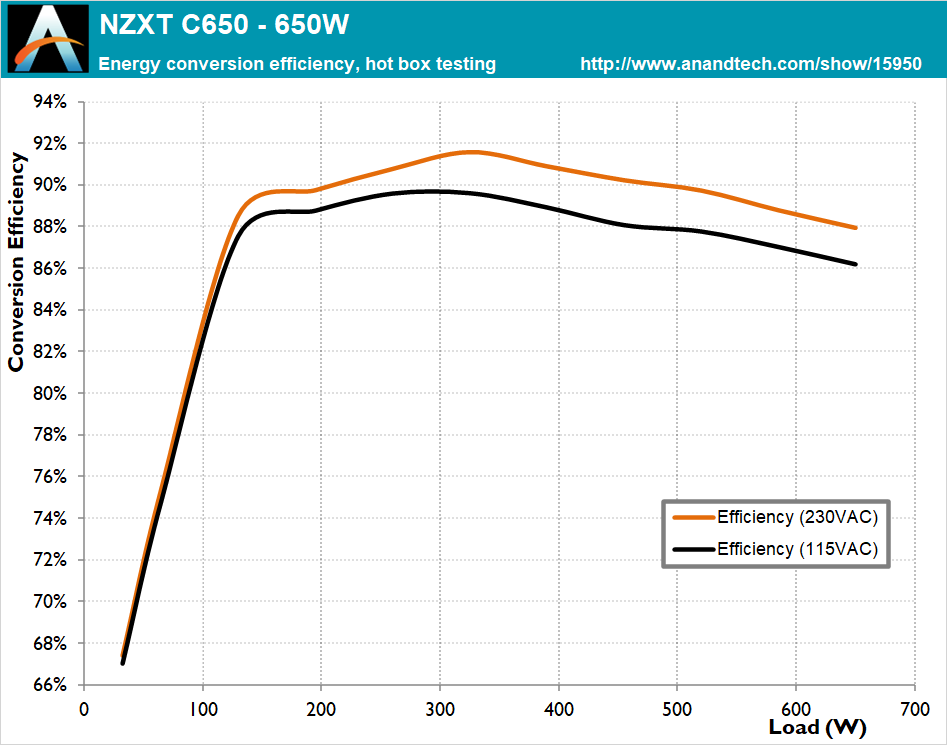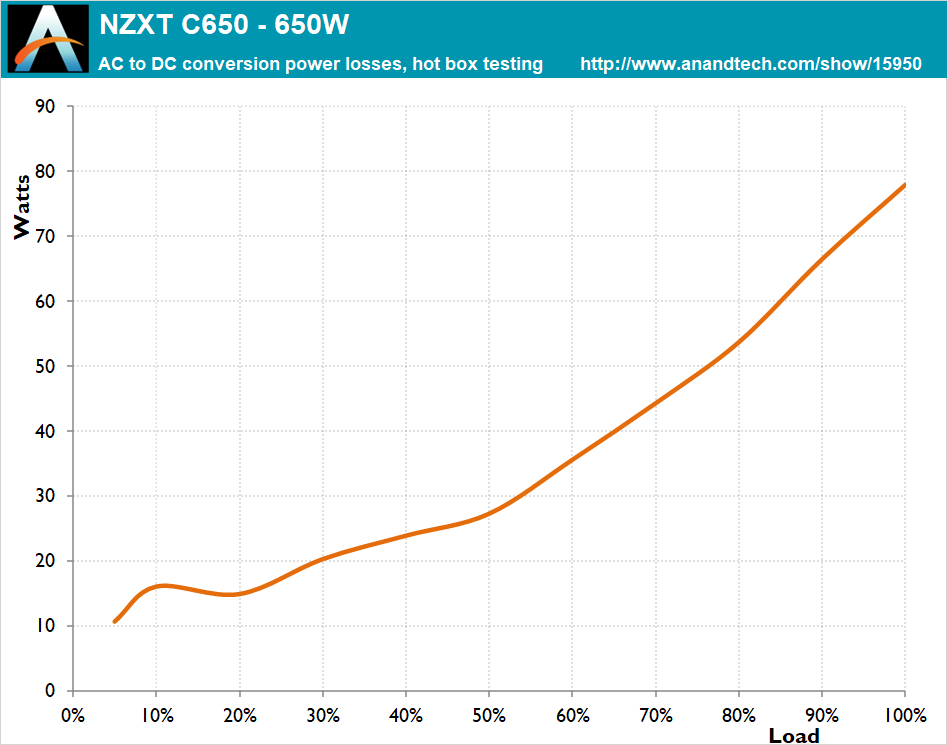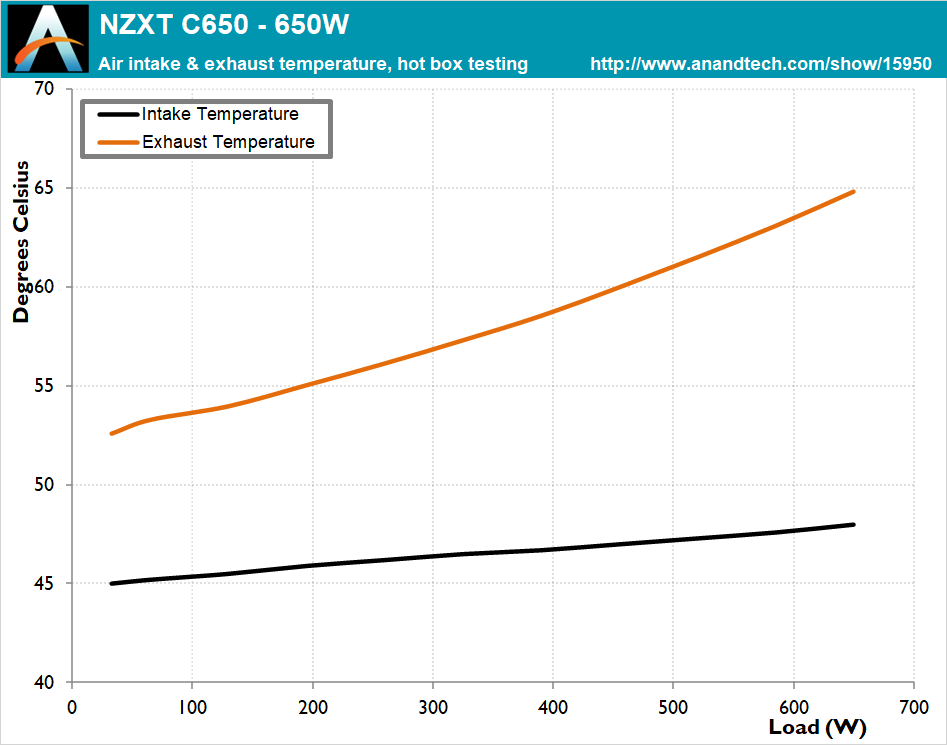The NZXT C650 650W PSU Review: Designed To Last
by E. Fylladitakis on August 11, 2020 8:00 AM EST- Posted in
- Cases/Cooling/PSUs
- PSUs
- 80Plus Gold
- NZXT
- 650W
- Modular
Hot Test Results
As we can see in the following tables, the NZXT C650 delivers great power quality. The maximum voltage ripple on the 12V line is 28 mV, an unimpressive figure nowadays, but less than a quarter of the ATX design guide's recommended 120 mV limit. Ripple on the secondary 3.3V/5V lines is considerably worse, reaching 28 mV on the 5V line with a recommended maximum at 50 mV. We can notice the same pattern on voltage regulation, with the 12V line very tightly regulated at 0.7% and the regulation on the secondary 3.3V/5V lines reaching slightly over 2%.
| Main Output | ||||||||
| Load (Watts) | 130.6 W | 326.19 W | 486.33 W | 647.57 W | ||||
| Load (Percent) | 20.09% | 50.18% | 74.82% | 99.63% | ||||
| Amperes | Volts | Amperes | Volts | Amperes | Volts | Amperes | Volts | |
| 3.3 V | 1.78 | 3.33 | 4.45 | 3.33 | 6.67 | 3.29 | 8.89 | 3.27 |
| 5 V | 1.78 | 5.05 | 4.45 | 5.01 | 6.67 | 5 | 8.89 | 4.97 |
| 12 V | 9.6 | 12.05 | 24.01 | 12.04 | 36.01 | 11.97 | 48.02 | 11.96 |
| Line | Regulation (20% to 100% load) |
Voltage Ripple (mV) | |||||
| 20% Load | 50% Load | 75% Load | 100% Load | CL1 12V |
CL2 3.3V + 5V |
||
| 3.3V | 2% | 10 | 16 | 20 | 22 | 12 | 24 |
| 5V | 1.6% | 12 | 16 | 22 | 28 | 14 | 24 |
| 12V | 0.7% | 16 | 20 | 22 | 28 | 30 | 20 |
Operation in high ambient temperatures does not affect the performance of the NZXT C650 considerably, regardless of the load. The average nominal load range (20%-100%) efficiency drops by 0.8% regardless of the input voltage, going down to an average of 89.8% (230 VAC) / 88.1% (115 VAC). There is very little change across the entire load range, suggesting that the components of the PSU are practically unaffected by the high ambient temperature. The component temperatures are high but not overly so.
As expected, the thermal control circuitry of the NZXT C650 correctly detects the high ambient temperature inside our hotbox and adjusts the fan’s speed accordingly. The NZXT C650 is not silent under these operating conditions, with the fan’s speed gradually increasing along with the load. Nevertheless, the sound pressure level tops out at just 50.2 dB(A), a figure significantly lower than what we would expect from a unit with a powerful 120 mm fan.















34 Comments
View All Comments
80-wattHamster - Monday, August 17, 2020 - link
Cuz it costs about the same to make a 500W power supply as a 350, and you can charge more for it.Funny thing is, even when you find a decent 350-ish unit, it'll probably cost more than you'd pay for a 500+ because volumes and channels and other such malarkey. Frustrating.
Threska - Monday, August 31, 2020 - link
Lesson number one. Two components to never cheapen out on. First is PSU, and the other is motherboard. Most intermittent problems people have can be traced to those two. It may cost more, but it may go through several rebuilds as well.Threska - Monday, August 31, 2020 - link
Well I'm a gamer with a Vega, and occasionally I can see the struggles with the latest games. So, no, "overpowered" is a moving target, especially in a seven year time-frame.